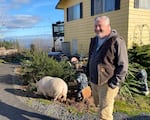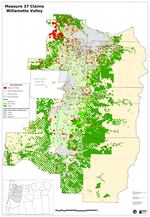OPB senior political reporter Jeff Mapes spent more than a year researching, reporting and producing “Growing Oregon,” a six-part podcast and web series looking at the evolution of Oregon’s unique approach to growth and the impact it has on our lives today. Here’s the story behind the story. In Part 1 we visited a time when Oregon’s farms and scenic beauty were under attack. In Part 2, we told the story of how Oregon leaders managed to write the state’s unique and controversial growth limits. In Part 3, we told the story of how unlikely activists pushed Oregon to mandate quality housing for everyone. Part 4 looked at the battle over a proposed freeway, and how its opponents ultimately run. Today we visit some of the opposition to Oregon’s land-use laws, and what happens when Oregonians don’t like what they’re told about what they can do on their own property. Listen to the story here:

Dorothy English and her dog, Leroy, c. 1984.
Courtesy of Doug Sellers / OPB
Doug Sellers is showing me the ridgetop property north of Portland where his grandparents once lived, when we’re interrupted by the squeals of a pet potbelly pig.
Sellers laughs and says it reminds him of a frequent quip from his grandmother, Dorothy English, during her days as a famous property rights activist in Oregon.
Critics of his grandmother would always say that if you didn’t have strict zoning limits, “you could have a pig farm next to you or a slaughterhouse,” he recalled. “Gramma said, ‘I’d rather have pigs than some of my neighbors.’”
Dorothy English’s long fight to develop this hilltop property in a rural corner of Multnomah County put her in the middle of a political battle that threatened Oregon’s growth system in the early to mid-2000s and made her quasi-famous at an age most people never even reach.
“Now I am 90, and I’m damned glad of it,” she told Oregon legislators in 2003. “And I intend to live to be 100 because there’s a lot of bastards I want to get even with.”
It’s easy to feel her spirit on this ridgetop not far from Skyline Drive. The Columbia River is so far below that it appears as a silver ribbon. You really feel above it all.

Doug Sellers at the ridgetop property north of Portland where his grandparents once lived, Feb. 7, 2022. Sellers’ grandmother Dorothy English, property rights activist in Oregon, would always say that if you didn’t have strict zoning limits, “you could have a pig farm next to you or a slaughterhouse,” he recalled.
Jeff Mapes / OPB
The scene reminds me of the intense love that Oregonians have for their land, and how that led people like Gov. Tom McCall and state Sen. Hector Macpherson to create a unique growth management system that sharply limited where developers can build to protect farmland and open space.
But that also led equally passionate people like English to fight for the right to do what they wanted with their property. They created a movement that almost took down the state’s growth controls.
The resulting turmoil was a reminder that Oregon’s system is in many ways a fragile social contract that will always face new challenges.
Property owners fight back
Back in the day when timber was king in Oregon, Georgia Pacific executive Bill Moshofsky was one of the leading knights of the industry.
The large timber companies generally supported Oregon’s growth management system as part of the odd coalition put together by McCall and other state leaders. The industry was happy to block urban sprawl from encroaching on their lands – as long as the new system didn’t try to regulate their logging practices.

William James “Bill” Moshofsky.
Courtesy of Oregon Property Owners Association
But Moshofsky came to see the growth controls in a darker light. First he got involved in helping kill a federal land planning bill. Then he supported the first ballot initiative attempts to weaken the growth system in the 70s.
After two failed attempts to run for Congress and a stint as state Republican chairman, Moshofsky joined a conservative group called Oregonians in Action in 1989. He helped revamp the group, which had been focused on broader conservative priorities, to focus on fighting the strict growth controls and protecting the rights of private property owners.
In many ways, he was trying to create a countervailing force to 1000 Friends of Oregon. That’s the watchdog group whose many lawsuits helped strengthen the system in its early years. Like 1000 Friends, Moshofsky was soon pushing his agenda in both the courts and the Legislature.
In a 1990 appearance on OPB, Moshofsky charged that the growth system was “putting Oregon in a straightjacket.”
The controls aren’t really about protecting farm and forest land, he said: “The purpose is to stop everything going on outside cities and leave that area as open space without paying for it.”
On the same program, 1000 Friends lawyer Robert Liberty countered that the “only straitjacket that belongs in this debate is on Bill for such a crazy description of what the program is doing.”
Liberty said the state was once again booming economically and growing rapidly in population.
“The question is,” said Liberty, “are we going to manage the growth, or are we going to grow like California?”
The two continued on in that vein, each portraying the other as the real radical.
It was a sign that the politics over the growth controls were changing. 1000 Friends now faced a more focused and determined opponent.
In addition, Democrats gradually lost control of the Legislature in the first half of the 1990s. The Republicans who took charge were not the moderate to liberal Republicans like McCall or Macpherson.
Instead, these were conservatives inspired by Ronald Reagan and his call to shrink the government. They thought those big environmental laws from the 1960s and 70s were hurting people who worked the land. And they included Oregon’s growth controls in that critique.

Dave Hunnicutt went to work for Oregonians in Action 1997.
Kristyna Wentz-Graff / OPB
Dave Hunnicutt, who went to work for Oregonians in Action 1997, said an increasing number of rural property owners were finding new restrictions that weren’t there when they bought their land.
These property owners were particularly galvanized during this period. That’s when the Land Conservation and Development Commission, which oversees the growth management system, approved new rules aimed at limiting the spread of so-called martini ranchers. The commission oversees the growth management system.
The commission required farmers in high value farmlands – designated as such by the quality of the soil – to show that they were making $80,000 a year in gross income before they could put a house on the property. Dick Benner, who headed the department then, said rural property owners found it too easy to get around the rules.
Some people were planting crops just long enough to get approval for a house in the country, Benner said, and then not doing anything with them “because it’s too much trouble.”
Hunnicutt said many rural folks who loved to farm but didn’t make a lot of money doing it saw things differently.
Benner and the commission were telling “well over half of the farmers in Oregon that you’re not a real farmer,” said Hunnicutt.
The Republicans who controlled the state Legislature passed several bills to push back on these rules, promote property rights and revamp the growth management system. But Democratic Gov. John Kitzhaber, elected in 1994, repeatedly vetoed them.
The big break for Oregonians in Action came almost by accident.
As the 2000 election approached, conservative activist Bill Sizemore decided to get involved in the property rights issue.
Sizemore was the state’s initiative kingpin then. He’d write initiatives by the bushel, mostly dealing with taxes and public employee unions. But at the urging of one of his staffers, he drafted a proposed constitutional amendment aimed squarely at government regulation of property.
The initiative, which became Measure 7, was sound-bite simple. It said landowners who lost property value because of government regulations could get relief. They’d either get government compensation or the right to develop.
This could be huge for people who had bought rural land before Oregon’s growth controls were enacted.
“I had no idea how big of a war it was going to start,” Sizemore recalled, chuckling at the memory.
One thing it did was worry Moshofsky and Hunnicutt. They loved the concept, but they were concerned it would lose and their movement would be set back.
“We tried to talk Bill into waiting” until a future election, said Hunnicutt, explaining that this would give Oregonians in Action time to write a more carefully worded measure.
Sizemore refused. But he did let Oregonians in Action run the campaign in the current election.
Opponents of Measure 7 were slow to get mobilized. 1000 Friends of Oregon missed the deadline for challenging the ballot title. That’s the language describing the measure on the ballot and it can make a real difference in campaigns.
Kitzhaber campaigned against the measure. So did Tom McCall’s widow, Audrey. They warned that Measure 7 could devastate protections for farms and forests – and even threaten public control of beaches.
To the surprise of many, voters handily passed Measure 7. It turns out that many of them saw the measure as a question of simple fairness. They didn’t think it would cause more sprawl or otherwise wreck the growth planning system.
In response to the results, supporters of the system rushed to the courts. The Oregon Supreme Court struck down Measure 7, saying it was improperly worded. (Oddly, the court’s problem was with a provision exempting sex-oriented businesses like strip clubs. The justices said that made the measure too broad for a constitutional amendment).
Still, it was clear to everybody the battle would continue.
And Dorothy English, the salty grandmother with a compelling tale of government mistreatment, would be right in the middle of it.
The unforgettable Dorothy English
English became involved with Oregonians in Action in the late 1990s, after her husband Nykee died.

Nykee and Dorothy English, when they lived in the Pendleton area, in approximately 1936.
Courtesy of Doug Sellers / OPB
Hunnicutt said he was immediately taken with her.
“She’s just such a likable person,” he said. “And she was so colorful. She truly was the poster child for some stuff that needs to be fixed.”
By poster child, he meant that her life story neatly personalized the property rights movement.
English grew up in small-town eastern Oregon riding a horse to school. She and her husband settled in Portland in the late 1930s. They had little more than the railroad job he had secured.
Sellers, her grandson, said English was a go-getter.
“She ran her own business,” he said. “She wasn’t afraid…to break the mold as a woman back in the 30s and 40s.”
She dabbled in real estate and opened a hamburger stand and school-supply store in North Portland. Eventually she got into the business of making and selling crafts. For years she traveled the country, teaching and selling at craft conventions.
She was the one who found that ridgetop land on McNamee Boulevard.
“In 1953, my husband and I bought 40 acres of view property,” English told a legislative committee in 2003. “It had no water, no inside plumbing, an old house.”
But she said they “rolled up our sleeves” and got to work. They set up a system to collect rainwater and also built a new house.
By 1970, they were thinking about subdividing the land. They could sell some plots and give others to their grandkids.

Dave Hunnicutt walks his dog Chuck, Aug. 8, 2022 in King City. Hunnicutt knew Dorothy English, saying, "She truly was the poster child for some stuff that needs to be fixed.”
Kristyna Wentz-Graff / OPB
Then Oregon adopted its statewide growth management system.
English said the Land Conservation and Development Commission, which oversees the system, developed new rules that “take complete control of your property, and they won’t pay you a damned dime.
Her problems weren’t just with the state. She might have been able to add some houses if she was just a few miles away across the Washington County line. But Multnomah County was different.
Mark Pengilly, English’s next-door neighbor, said the county – as well as Metro and the City of Portland – wanted to protect the forest running up to the ridgetop. They saw it as an important wildlife corridor, including for an elk herd.
The local governments also wanted to protect the forested view that people saw from below. And the city was interested in expanding Forest Park. So the county repeatedly rejected her development requests.
Robert Liberty headed 1000 Friends when English first started to gain some celebrity. He said he had some sympathy for her plight. But he noted her property still grew in value even without additional houses.
Subdividing her property was “her economic dream,” said Liberty. “It’s not her property right. I don’t have a property right to have a K Mart on my property.”
Multnomah County records show that English and her husband bought their 40 acres in 1953 for $4,500.
They sold half the land in the 1980s for an undisclosed price. Zillow estimates the remaining land and house is worth more than $1 million today.
So the value of their investment has risen more than 20 times the rate of inflation – and that doesn’t include what they got for selling half of the acreage.
English always said the big increase in the value of her land was besides the point.
“Now to me, it doesn’t help one bit, the value of my property,” she said at that legislative hearing. “Sure, it’s great. What am I supposed to do with it?”
Because she couldn’t put any more houses on it, she said, she couldn’t raise money for her retirement or to help her grandchildren. And she didn’t want to sell the land and be forced to move somewhere else.
As a result, she found herself in a cash crunch.
Her grandson Doug Sellers said he and his wife eventually had to help pay her bills.
English had supported the Measure 7 property-rights initiative in 2000. She became even more well-known after it passed. Her story attracted news coverage and attention from sympathetic legislators.
Her state senator at the time – Democrat Charlie Ringo – introduced a bill in 2003 to give her an exception from state law and county regulations so she could put up to six houses on her land.
Even though the bill didn’t help other landowners, Hunnicutt at Oregonians in Action saw it as a good first step. He warned that he’d launch another initiative campaign around her story if legislators didn’t pass the exemption.
“I’ll be happy to help broadcast her story to God and country,” he said, adding that, “it’s hard not to feel sympathetic toward her.
Legislators passed the relief bill for English, and they sent it to the governor for his signature. Democratic Gov. Ted Kulongoski met with English and expressed his sympathy.
But he vetoed the bill, saying it should be up to counties – not the Legislature – to decide whether to make exceptions for individual landowners.
Hunnicutt said Oregonians in Action probably would not have gone back to the ballot if Kulongoski had given English what she wanted. For one thing, Oregonians in Action would no longer have English – their “star witness,” Hunnicutt said – pressing their case.
In addition, if Kulongoski had signed the bill, it would have been a sign he was open to further compromises.
Following the veto, Oregonians in Action steamed ahead with a new property-rights initiative in 2004.
Known as Measure 37, the new initiative didn’t attempt to amend the constitution. That made it less subject to legal challenge.
But Measure 37 was basically the same idea as the earlier initiative. It said that landowners could get either compensation or the right to develop for government regulations imposed after they had bought their property.
And, as promised, English was the star of their TV and radio campaign.
“I’m 91 years old,” English said in one ad. “My husband is dead. And I don’t know how much longer I can fight.”
The advertising was mostly financed by much bigger landowners. Timber interests – many of whom wanted to keep their development options open – provided most of the $1 million spent by the Measure 37 campaign.
Opponents spent more than twice that amount. Their big donors included environmental groups and some wealthy supporters of the growth controls.
But, once again, opponents couldn’t figure out how to convince voters this measure could dismantle Oregon’s growth management system. Polls showed most voters believed they were just helping regular folks like Dorothy English.
In a way, this wasn’t surprising. Oregon’s statewide land use system is devilishly complicated, with its welter of rules, legal opinions and planning jargon. That complexity makes it hard for voters to connect the dots.
Hunnicutt was actually happy when opponents of Measure 37 ran ads trying to say Oregon’s farm and open space protections were at risk.
“That’s not going to be an issue that resonates,” said Hunnicutt, over his message that people should get compensated if their land is devalued.
“We’ll win that argument every time,” he added, “and we essentially cleaned their clock.”
That was indeed the case. Measure 37 won in every county except for one – Benton County, home to Oregon State University. Even reliably liberal Multnomah County voted for 37.
English was thrilled.
“She felt vindicated,” said Sellers, adding that she felt that something was finally “going to come together so she could give the land to us to build, and we could be here with her.”
It didn’t turn out to be that simple.
Ballot battles
After Measure 37 passed, longtime property owners had two years to file a claim, demanding compensation or the right to development.
And did they ever.
By the filing deadline, more than 7,500 claims were filed statewide covering an area of more than 750,000 acres. That’s equal to just over a fifth of the entire Willamette Valley.
Most of the claimants were relatively small landowners like English. But several larger property owners wanted to build subdivisions. Most eye-catching of all, the Plum Creek Timber Company filed claims to develop 32,000 acres on the Oregon coast.
Suddenly, the horror stories put forth by opponents seemed true.

This Oregon Department of Agriculture map from 2007 shows Measure 37 claims in the Willamette Valley. Maps showing the widespread development claims following passage of the 2004 property rights initiative helped build voter support for rolling back the initiative.
Courtesy of Oregon Department of Agriculture / OPB
A widely circulated map from the state Department of Agriculture showed claims clustered in highly contested areas like the coast, the countryside around Portland, and the Hood River Valley.
That map was “quite an eye-opener to the public,” said Greg Macpherson, then a Democratic state representative from Lake Oswego. It led many to think, “this isn’t what we thought we were voting for,” he added.
Macpherson is the son of Hector Macpherson, the legislative sponsor of Oregon’s original growth controls.
After Democrats regained control of the Legislature in 2007, he got involved in pushing his fellow legislators to rewrite Measure 37.
Democrats eventually came up with their own ballot measure on property rights and regulation. They walked a fine line as they tried to turn voters around. Their proposal, which became Measure 49, would help out small landowners while shutting down the big development proposals.
They did everything they could to focus voter attention on the idea that they were trying to save Oregon from ruinous urban sprawl. They didn’t let state elections officials write a description of the measure that was placed on a statewide special election ballot in November of 2007.
Then backers of Measure 49 raised more than $4 million for an advertising campaign that could have been written by Tom McCall.
“Oregon’s farms, forests and water make our state special,” said one TV ad. “But today, thousands of Measure 37 claims have been filed to turn farmland and forests across Oregon into strip malls, big box stores and subdivisions. That’s wrong.”
Oregonians in Action leaders campaigned vigorously against Measure 49. But now they were on the defensive. The Democrats were promising to help small landowners while still protecting the countryside.
Measure 49 allowed eligible property owners to get as many as three new homes on their land. In some cases, they could get up to 10. The measure also said landowners could get compensation for regulations passed after Jan. 1,2007.
Measure 49 won big, and Hunnicutt quickly went from denouncing the measure to embracing it.
“I believe that Measure 49 was the greatest victory that private property owners have had, ever, in this state,” Hunnicutt told me in an interview.
Why had Oregonians in Action worked so hard to defeat it? Hunnicutt said he and other leaders felt they had to fight to preserve Measure 37 in full to avoid breaking faith with their original supporters.
And in the end, a lot of rural property owners did get homes they once could not. The state has now authorized more than 6,000 new homes under Measure 49, although many have not actually been built.
On the other side, Measure 49 backers were just pleased that they basically preserved Oregon’s growth management system. But Greg Macpherson said the fight was a reminder that Oregonians can’t take the land protections for granted.
“It is a constant process of trying to remind people why it is that Oregon looks different then other places,” he said.
However, Measure 49 did not clarify things for one aggrieved landowner – Dorothy English. Her own legal battle just kept getting murkier. And she was running out of time.
One last ridgetop fight
English filed a claim for $1.15 million on Dec. 2, 2004. She said that’s what she lost because she couldn’t divide her remaining 20 acres into eight homesites.
Lisa Naito, who was then a Multnomah County commissioner, said she and her colleagues were ready to let her build. But first, the county had to make sure she met health and safety standards.
English argued that county officials were adding regulations that made it impossible for her get a construction permit. Naito said the country tried to work with her.
“I remember our staff was actually trying to be really reasonable,” Naito said, “but by then it was so political.”
That’s not how her grandson remembers it.
“Multnomah County never looked to compromise ever,” said Sellers. “Not once. They didn’t budge on anything.”
The two sides went to court. By now, English had a prominent Portland law firm representing her, and she was simply trying to get money – a lot of it – from the county.
The case got so convoluted that the different judicial opinions were labeled like movie sequels. I had to laugh when I read one Court of Appeals decision that said, “As we explained in English II…”
“Every other day,” said Sellers, “it was turned down by a court, it went to a different court, it went to a higher court. It was constantly being battled and challenged. That was hell on her.”
Measure 49′s passage only added more fuel for yet another round of legal fighting.
Mark Pengilly remembers hearing his phone ring one spring day in 2008. It was Dorothy, his next-door neighbor and friend.
“I picked up the phone and she said, ‘I’m about out,’” he recalled. “We talked for a few minutes. And the next day she died.”
She was 95. Her obituary ran in newspapers around the state.Her legal battles continued.
Two years later, the Oregon Supreme Court ordered Multnomah County to pay her estate $1.15 million. Her lawyers got the same amount in legal fees and other expenses.
More than a decade later, Sellers and his wife live at Dorothy English’s old house. They’ve cared for his ailing mother – English’s daughter – there.
Sellers and his two brothers spent some of the settlement on a small house at the coast. They put in a well to replace the rainwater collection system. They also used the settlement to pay taxes, home repairs and legal costs that weren’t covered by the settlement.
“It seems like a lot of money,” Sellers said. “It’s just not a lot left at the end of the day.”
In some ways, the land seems ideally situated to be worth a lot of money. I could see some tech bro being interested, particularly if he likes to take his Tesla on twisty roads. After all, the property is just 30 minutes from downtown – and even less than that to the Nike headquarters near Beaverton.
Living here isn’t for everybody, though, Sellers said. Winters can be cold and windy. any people want to be closer to neighbors, schools and shops.
But Sellers said he appreciates the wildlife – which includes that local elk herd, bobcats and even a cougar or two. And he likes the solitude.
“There’s not neighbors all stacked on top of each other,” he said, noting that the land could have grown a lot more crowded if his grandmother had her way..
But he said he would have abided by her wishes.
“It was her property,” he said, “to do with what she wanted.”
Next week: Oregon’s revolutionary system for managing growth has done a lot of what its creators envisioned. Vast parts of the state remain pristine, and even suburban communities feel more urban – more walkable and environmentally friendly – than in other states. But the rules that have kept Oregon so special have also led to many of the land use fights we’re waging today – political battles over how dense town and cities should be, how much of an influence tight growth laws have on housing prices and where all these people moving into Oregon over the next half century are going to live and work.
The Growing Oregon audio story is available through the OPB Politics Now podcast feed.

OPB Sta
